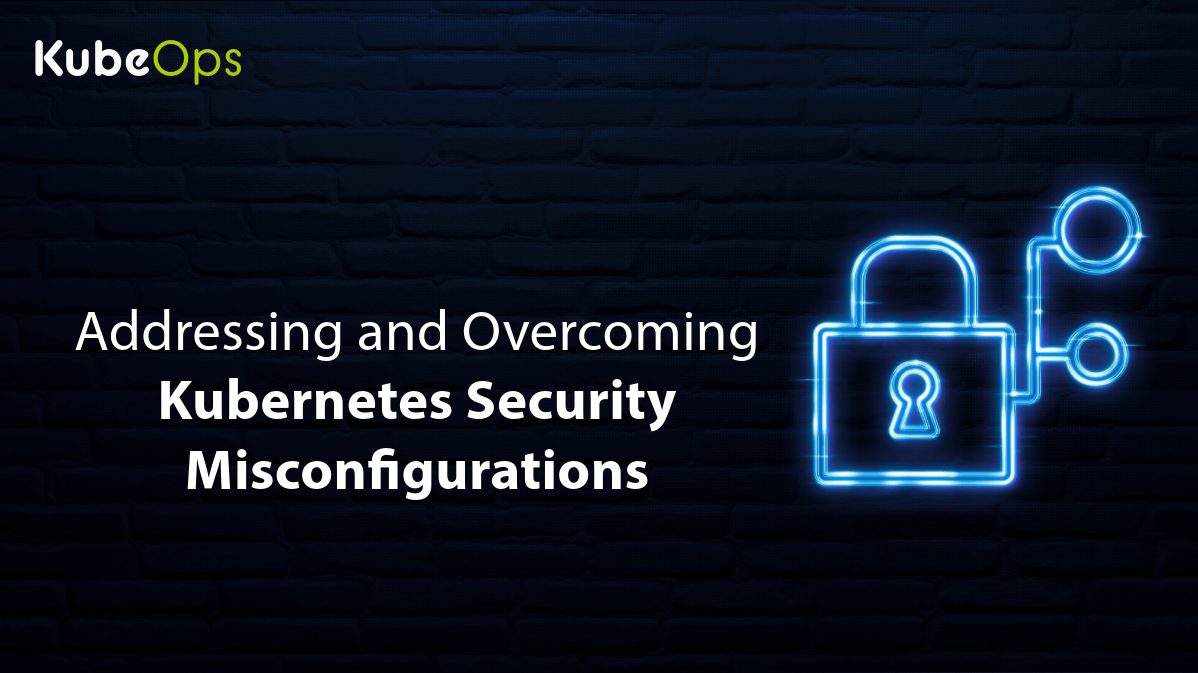Blogs
Addressing and Overcoming Kubernetes Security Misconfigurations


Introduction
Kubernetes, an essential tool in the modern IT landscape, offers immense benefits in deploying and managing containerized applications. However, its complexity and dynamic nature often lead to security misconfigurations, posing significant risks. This blog post delves into understanding these risks and provides strategies to mitigate them effectively.
The Predominance of Misconfigurations in Kubernetes Security Vulnerabilities
One of the most significant challenges in securing Kubernetes environments lies in the complexity and dynamic nature of its configurations. Misconfigurations in Kubernetes not only are common but, according to industry experts and reports, represent the main reason for security problems within these environments. This assertion is supported by numerous studies and analyses from reputable cybersecurity organizations.
A comprehensive report by the Center for Internet Security (CIS), for instance, indicates that misconfigurations in Kubernetes clusters are a leading cause of security incidents. These misconfigurations can range from exposed dashboard interfaces, improperly configured network policies, to default settings that do not enforce adequate security measures. The CIS Kubernetes Benchmark provides a set of recommendations for configuring Kubernetes to enhance security, underscoring the importance of proper configuration to prevent vulnerabilities.
Similarly, research conducted by Palo Alto Networks' Unit 42 highlights that approximately 65% of Kubernetes incidents can be traced back to misconfigurations. This stark statistic illustrates the critical need for organizations to focus on accurate configuration settings as a cornerstone of their Kubernetes security strategy.
The prevalence of misconfigurations as a source of security issues in Kubernetes is further corroborated by Red Hat's 2021 State of Kubernetes Security report, which found that a significant number of organizations have experienced a security incident in their Kubernetes and container environments due to misconfigurations. These incidents often lead to unauthorized access, data breaches, and service disruptions, emphasizing the critical role that configuration management plays in securing Kubernetes ecosystems.
Mitigating Misconfiguration Risks
To mitigate the risks associated with Kubernetes misconfigurations, organizations should adopt a multi-layered approach that includes:
- Implementing Automated Configuration Management Tools: Tools that can automatically detect and remediate misconfigurations play a crucial role in maintaining the security of Kubernetes environments.
- Adhering to Industry Best Practices and Benchmarks: Following guidelines such as those provided by the CIS Kubernetes Benchmark can help organizations configure their Kubernetes clusters securely.
- Continuous Education and Training: Ensuring that team members are aware of the potential risks associated with misconfigurations and are trained on best practices for configuration management is essential.
- Regular Security Audits and Assessments: Conducting periodic security assessments can help identify and rectify misconfigurations before they can be exploited by attackers.
Understanding the Risk Landscape
The Complexity of Kubernetes Environments
Kubernetes' intricate architecture, involving multiple components and layers, makes it challenging to maintain a secure configuration. Each element, from pods to services, has its unique security considerations.
Misconfigurations often arise due to the complexity of the environment, especially when security settings are neglected or misunderstood during the setup.
Misconfigurations as a Security Threat
Misconfigurations in Kubernetes are a primary vector for security incidents. They can lead to unauthorized access, data breaches, and service disruptions.
Common misconfiguration issues include exposed dashboard interfaces, inadequate network controls, and insufficient role-based access controls.
Areas Prone to Misconfiguration
- RBAC Policies: Incorrectly configured RBAC policies can give users or applications more privileges than needed, violating the principle of least privilege.
- Network Policies: Insufficient network policies can expose internal services to unwanted network segments or the public internet.
- Pod Security Policies: Without proper pod security policies, containers might run with high privileges, increasing the risk if they are compromised.
- Secrets Management: Mismanagement of secrets, such as hardcoding in application code or Docker images, can lead to credential leaks.
Potential Consequences of Misconfigurations
Data Exposure and Breaches
One of the most severe consequences of misconfiguration in Kubernetes is the exposure of sensitive data. Improper settings can leave databases, APIs, and internal services exposed to unauthorized access, leading to significant data breaches.
Such incidents not only result in loss of sensitive data but also harm the organization's reputation and incur heavy regulatory fines, especially in cases of non-compliance with data protection laws like GDPR or HIPAA.
Service Disruptions and Downtime
Misconfigurations can cause operational issues leading to service downtime. For example, incorrect network settings can disrupt communication between microservices, while inadequate resource limits may lead to system overloads.
Downtime affects customer experience, business operations, and can lead to substantial financial losses. In some cases, resolving these disruptions can be challenging, requiring extensive troubleshooting and recovery efforts.
Compliance and Legal Implications
Non-compliance with industry standards and regulations is a significant risk arising from Kubernetes misconfigurations. Failing to adhere to compliance standards can result in legal actions, hefty fines, and a loss of trust among customers and stakeholders.
Organizations operating in highly regulated industries, such as finance and healthcare, need to be particularly vigilant about maintaining compliance in their Kubernetes deployments.
Security Incidents and Cyber Attacks
Kubernetes environments that are not correctly configured are prime targets for cyber attacks. Misconfigurations can be exploited for unauthorized access, data theft, or even to gain control over the entire cluster.
Attackers can exploit vulnerabilities like exposed dashboard interfaces, unsecured API endpoints, or inadequate role-based access controls to initiate attacks ranging from data theft to ransomware.
Escalation of Privileges
Incorrectly configured role-based access controls or service accounts in Kubernetes can lead to privilege escalation issues. Attackers or malicious insiders can exploit these to gain higher privileges than intended, allowing them to access sensitive areas of the Kubernetes cluster.
Such escalations can lead to severe security breaches, as attackers could modify, delete, or exfiltrate critical data, or deploy malicious applications within the cluster.
Resource and Financial Wastage
Misconfigurations can lead to inefficient resource usage, where applications consume more resources than necessary. This not only reduces the overall system performance but also leads to increased operational costs.
Addressing these issues often requires additional human resources and financial investment in troubleshooting, rectifying, and optimizing the Kubernetes environment.
Reputation Damage
Beyond the immediate operational and financial impacts, Kubernetes misconfigurations can damage an organization's reputation. Security incidents and data breaches can erode customer trust and deter potential clients, affecting long-term business prospects.
In a digital world where news travels fast, even a single incident of data breach or service disruption can have lasting negative effects on a company's public image.
Identifying Misconfigurations
Conducting Regular Audits and Reviews
Periodic audits of Kubernetes configurations are vital in identifying potential vulnerabilities and misconfigurations.
Utilize tools like Kubernetes audit logs and configuration validation tools to systematically review cluster settings and ensure compliance with best practices.
Leveraging Automated Security Tools
Employ automated security scanning tools to detect misconfigurations. These tools can regularly scan your environment and provide real-time alerts on potential security issues.
Automated tools can also suggest corrective actions and best practices to fix identified misconfigurations.
Addressing Common Misconfigurations
RBAC and Access Controls
Conduct thorough reviews of RBAC policies and ensure they align with the principle of least privilege. Regularly update these policies to reflect role changes or evolving access requirements.
Implement a robust process for managing and auditing RBAC policies, ensuring that only the necessary access is granted and revoked promptly when no longer needed.
Network Policies and Segmentation
Establish clear network segmentation within your Kubernetes clusters. Implement network policies that restrict communication between pods and services to only what is necessary.
Regularly review and update network policies to adapt to changes in the network architecture and application requirements.
Pod Security Policies
Implement and enforce strict Pod Security Policies (PSPs) to control the security features and capabilities that pods can access.
Regularly review and update PSPs to ensure they meet the evolving security needs of your applications without compromising their functionality.
Secrets Management
Avoid embedding secrets directly into application code or Docker images. Utilize Kubernetes Secrets for managing sensitive information securely.
Ensure secrets are encrypted both at rest and in transit. Implement access controls to restrict who can access these secrets.
Resource Limitations
Define clear resource quotas and limits to prevent any application or user from monopolizing system resources. This not only ensures fair resource allocation but also mitigates denial-of-service attacks.
Implement monitoring and alerting systems to detect and respond to resource abuse or anomalies in resource usage patterns.
Logging and Monitoring
Establish comprehensive logging and monitoring mechanisms to detect unusual activities or signs of a breach.
Integrate logging tools with real-time alerting systems to enable quick detection and response to potential security incidents.
Security Contexts
Define and enforce security contexts for your containers and pods. This includes running containers as non-root users and limiting access to host resources.
Regularly review and update security contexts to align with the current threat landscape and security best practices.
Continuous Security Education
Foster a culture of security awareness within your organization. Provide regular training and updates on Kubernetes security best practices to all team members involved in deploying and managing Kubernetes environments.
Encourage proactive security practices, such as peer reviews of configurations and sharing knowledge on new security threats and mitigation techniques.
Preventative Measures for Kubernetes Security
Implementing Policy as Code
Adopt a policy-as-code approach to manage and enforce security configurations in your Kubernetes environment. This allows for versioning, tracking changes, and rolling back configurations when necessary.
Use tools like GitOps for managing Kubernetes configurations, ensuring that any changes are reviewed, tested, and approved before being applied to the production environment.
Staying Proactive in Security Posture
Stay informed about the latest security advisories and updates from the Kubernetes community. Regularly update your Kubernetes clusters to the latest versions with security patches.
Participate in Kubernetes security forums and communities to stay abreast of emerging threats and learn from the experiences of others in the community.
Integrating Third-Party Security Solutions
Consider incorporating third-party security solutions that offer advanced monitoring, policy enforcement, threat detection, and response capabilities.
Evaluate and select security solutions that integrate seamlessly with your Kubernetes environment and align with your organization's security requirements and policies.
Conclusion
Addressing security misconfigurations in Kubernetes is an ongoing process that requires diligence, expertise, and a commitment to continuous improvement. By understanding the common areas of misconfiguration, employing tools and processes to identify and address these issues, and fostering a culture of security awareness, organizations can significantly enhance their Kubernetes security posture. This comprehensive approach ensures that your Kubernetes environment is not only robust and scalable but also secure from the ground up, safeguarding your infrastructure against the evolving landscape of security threats.

